As the third-largest U.S. state, California spans an immense 163,696 square miles. With such a huge area, it’s not surprising that California has it all when it comes to geography. From mountains to deserts to miles of stunning coastline, there is always something for everyone to enjoy. It’s the same when it comes to animals too, as the state has hundreds of animals that call it their home — including snakes. With 46 species and seven that are venomous, California really isn’t the best state to visit if you’re afraid of them. However, if you don’t mind snakes then it’s a good idea to know which is which. That’s why we’re about to discover some of the brown snakes in California!
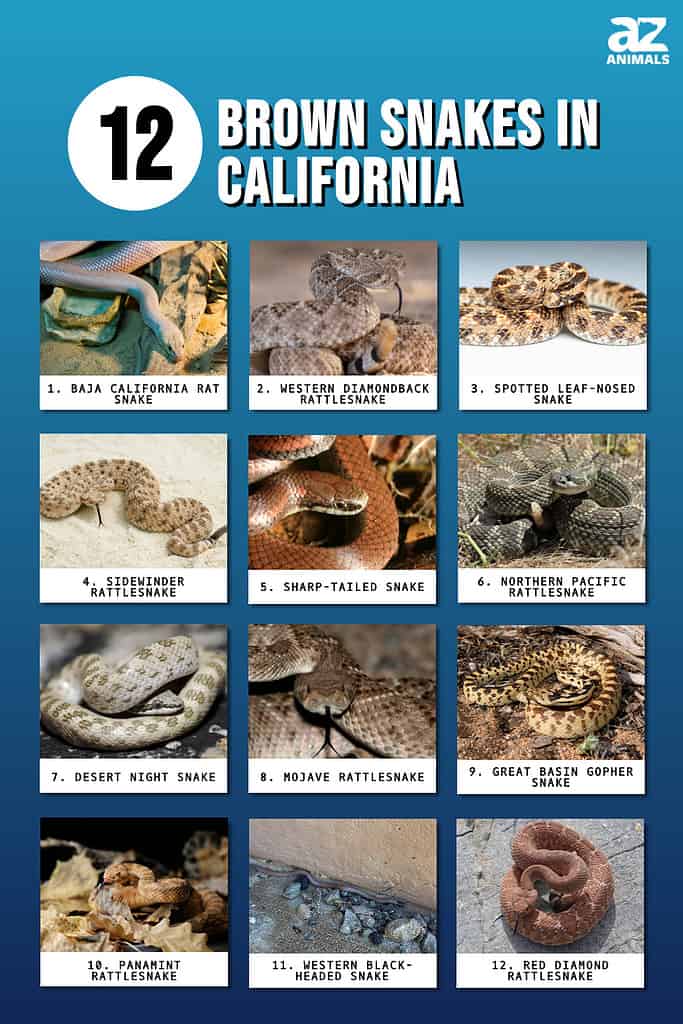
1. Baja California Rat Snake (Bogertophis rosaliae)
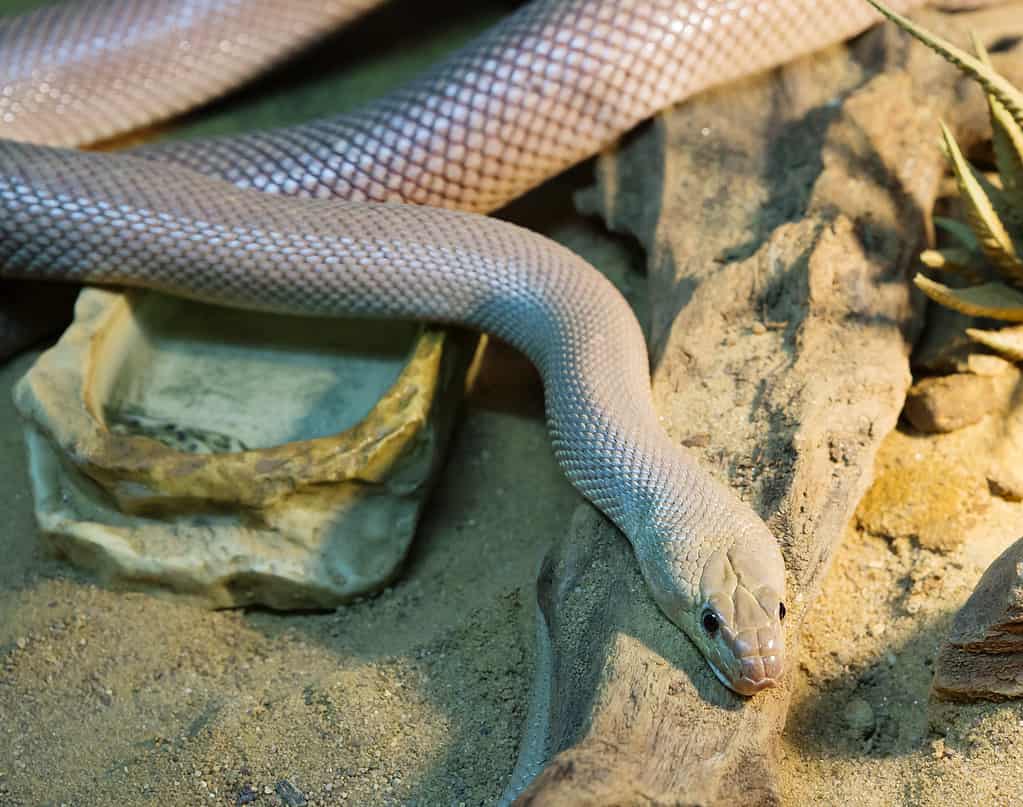
The Baja California rat snake is large and powerful but is not dangerous to humans.
©iStock.com/User10095428_393
We’ll kick off the list with the Baja California rat snake, which is not dangerous to humans. Baja California rat snakes are large, powerful snakes and range between 33 inches and five feet long. They are a uniform reddish-brown color on their dorsal side but have a yellow to green color on the lower part of their sides. They typically inhabit rocky areas in Baja California and are listed as a species of special concern in California.
2. Western Diamondback Rattlesnake (Crotalus atrox)

The western diamondback rattlesnake is one of the most dangerous snakes in California due to their aggressive nature.
©Alexander Wong/Shutterstock.com
One of the largest snakes in the state is the western diamondback rattlesnake, which can reach 90 inches long. Western diamondback rattlesnakes have a grayish-brown ground color that is overlaid with dark brown diamond-shaped markings. They typically inhabit desert regions in California — especially the Mojave and Sonoran deserts. Western diamondback rattlesnakes are one of the most dangerous snakes in the state due to their large fangs, high venom yield, and aggressive nature. When they are threatened, they coil themselves and rattle a warning before striking repeatedly.
3. Spotted Leaf-Nosed Snake (Phyllorhynchus decurtatus)
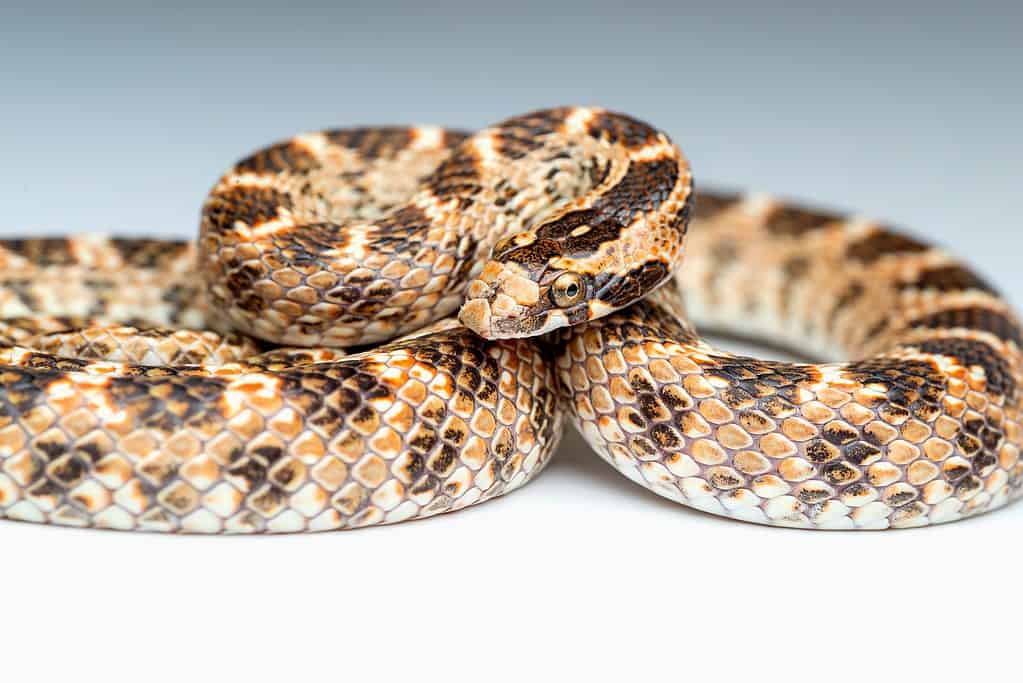
The spotted leaf-nosed snake is a brown snake in California with a blunt, short snout.
©KHALID ALHADRAMI/Shutterstock.com
With a length of only 12 to 20 inches, the spotted leaf-nosed snake is one of the smallest brown snakes in California. These snakes have a unique appearance as their snout is short and blunt but have a large rostral scale over the nose that is higher than the surrounding scales. This is often described as making them look as though they have a leaf folded over their nose, hence the name. Spotted leaf-nosed snakes are pale to pinkish tan with brown blotches. They have a fairly plain belly but weakly-keeled dorsal scales. Spotted leaf-nosed snakes live in the Colorado, Mojave, and Sonoran deserts.
4. Sidewinder Rattlesnake (Crotalus cerastes)
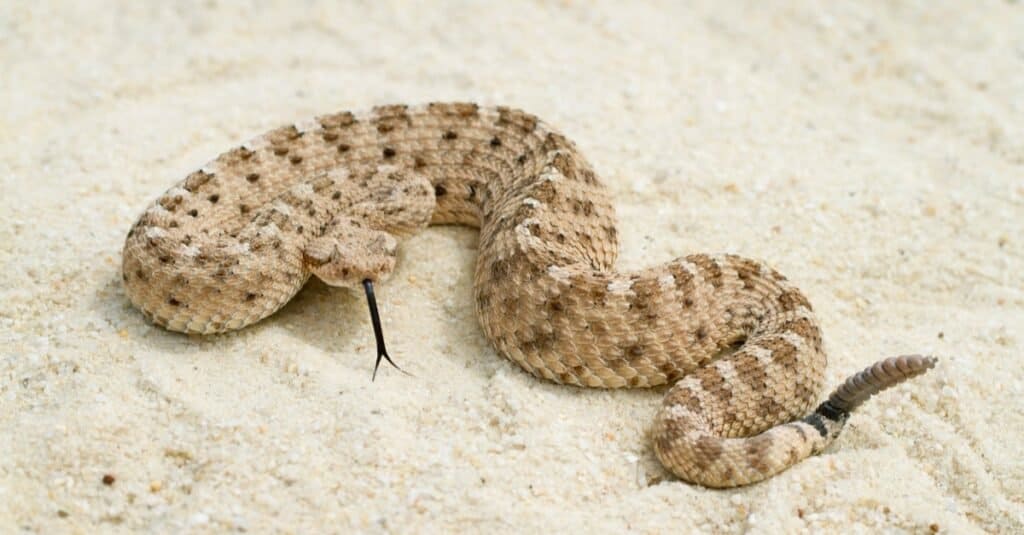
Another brown snake in California is the venomous sidewinder rattlesnake.
©Mark_Kostich/Shutterstock.com
With their unusual sideways motion, sidewinder rattlesnakes are easily recognizable. Their unique movement allows them to easily traverse loose sand and dunes and is particularly useful across the Californian deserts where they live. Sidewinders are 17 to 30 inches long and typically have yellowish-brown bodies with up to 47 darker blotches. They possess fairly weak venom — especially when compared to some of the other snakes on our list — as well as a low venom yield. Although these snakes are not usually dangerous to healthy adults, it is still important to have any bites treated by a medical professional as you will still need to be administered anti-venom.
5. Sharp-Tailed Snake (Contia tenuis)
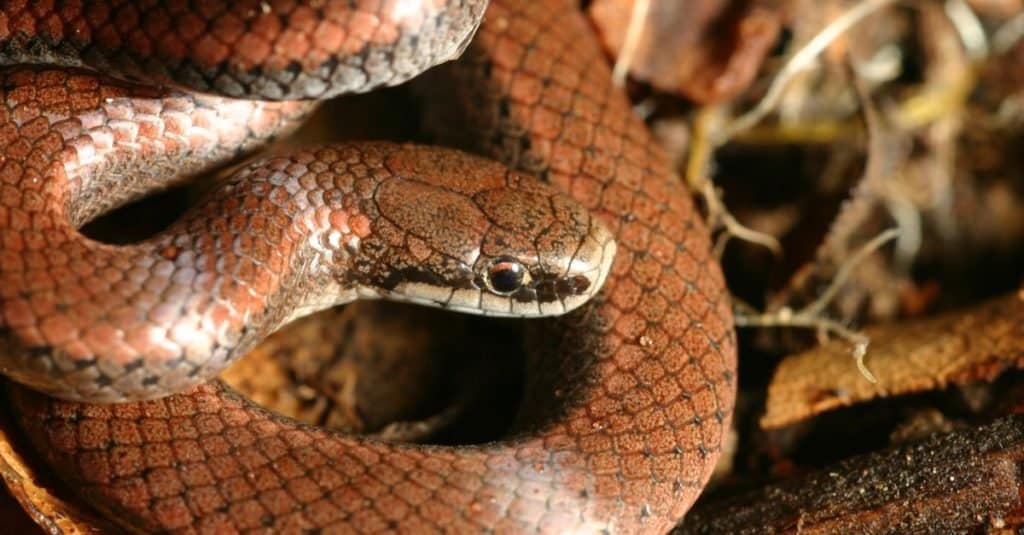
The sharp-tailed snake is shy and prefers to hide under logs and rocks in moist woodlands and forests.
©Michael Benard/Shutterstock.com
Another unusual-looking small snake is the sharp-tailed snake, which has a long, sharp tail spine extending from the last vertebra. Although it looks menacing and is sometimes thought to be poisonous, the tail spine is actually completely harmless. Sharp-tailed snakes are 12 to 18 inches long with brown bodies and black and white bellies. They are shy snakes and prefer to hide underneath logs and rocks and live in moist woodlands and forests. When they are disturbed they tend to simply curl up into a ball.
6. Northern Pacific Rattlesnake (Crotalus oreganus)
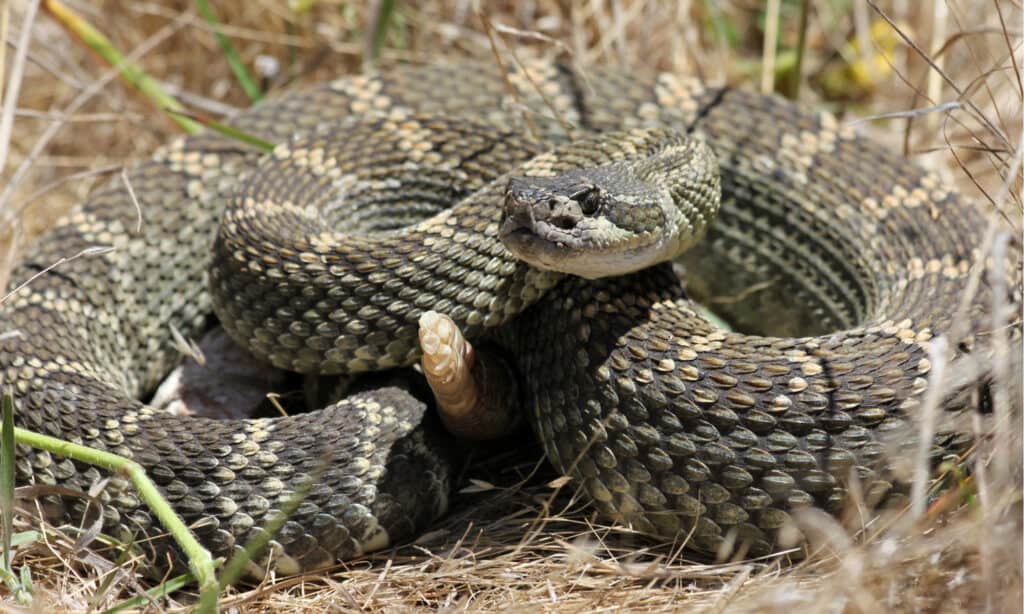
The pacific rattlesnake is also known as a western rattlesnake and calls California home.
©Ryan M. Bolton/Shutterstock.com
The next brown snake in California is the northern pacific rattlesnake, which is also known as the western rattlesnake. These snakes vary widely in size and can be anything from 39 to 64 inches long. They typically have a dark brown ground color with darker blotches. The blotches are usually larger than the space around them and are often outlined with white. They also have a yellow belly with brown spots. Northern Pacific rattlesnakes live in grasslands, woodlands, and talus slopes across much of the northern and northwestern regions.
7. Desert Night Snake (Hypsiglena chlorophaea)
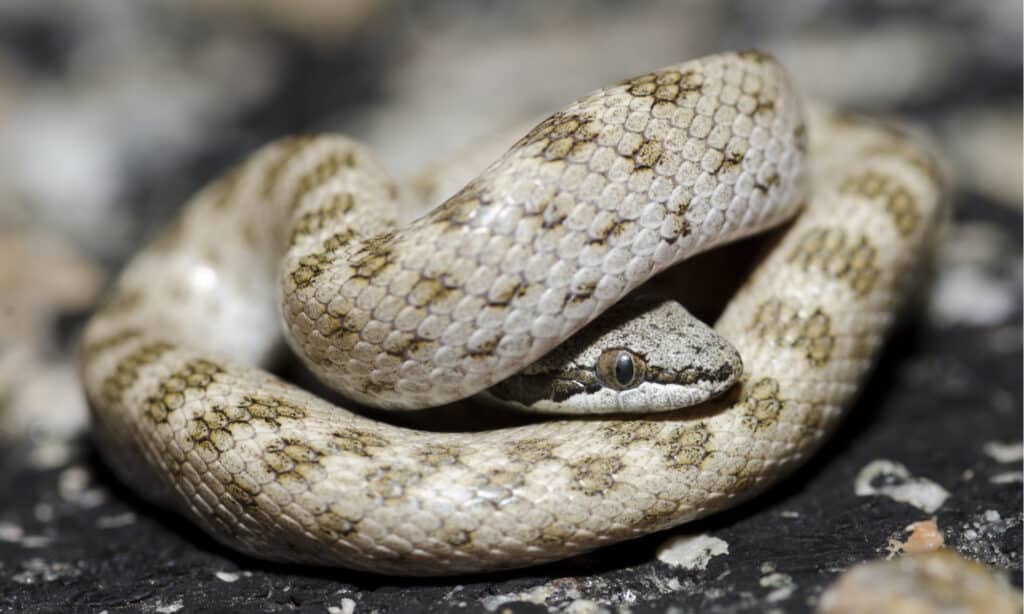
Brown snakes in California include desert night snakes, which are not considered dangerous to humans.
©Jason Mintzer/Shutterstock.com
Found across southern California, desert night snakes live in a variety of habitats — including grasslands, deserts, and chaparral. However, they do tend to stick to areas where there is plenty of cover for them to hide in. Desert night snakes are 12 to 26 inches long and are light brown to tan with dark brown blotches. They are nocturnal snakes and prey mainly on lizards and amphibians. They contain a mild venom in their saliva, which they chew into their prey rather than injecting it with fangs. However, these snakes are not considered to be dangerous to humans.
8. Mojave Rattlesnake (Crotalus scutulatus)
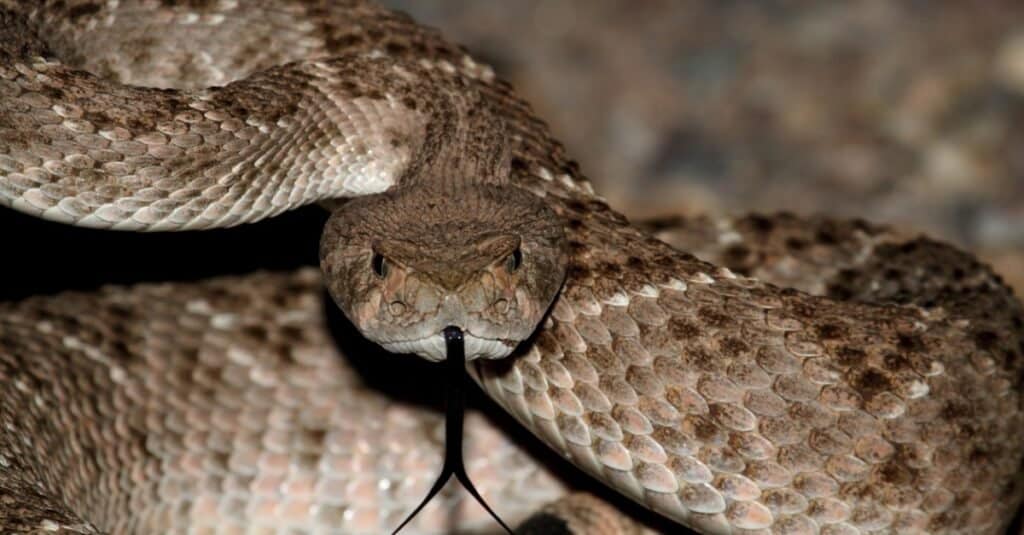
The venomous Mojave rattlesnake is the most dangerous rattlesnake in California and in the world.
©iStock.com/SteveByland
The most dangerous rattlesnake in the world is the Mojave rattlesnake, which possesses a combination of neurotoxic and hemotoxic venom. The neurotoxic part of the venom attacks the brain and the nervous system, while the hemotoxic portion attacks the body’s tissue and muscles. A lethal dose for an adult human is estimated to be just 10 to 15mg. Mojave rattlesnakes are two to four feet long and are brown with dark brown diamond markings. They live in lowlands and deserts in the southeastern region of the state — particularly Inyo, Kern, Los Angeles, and San Bernardino counties.
9. Great Basin Gopher Snake (Pituophis catenifer deserticola)
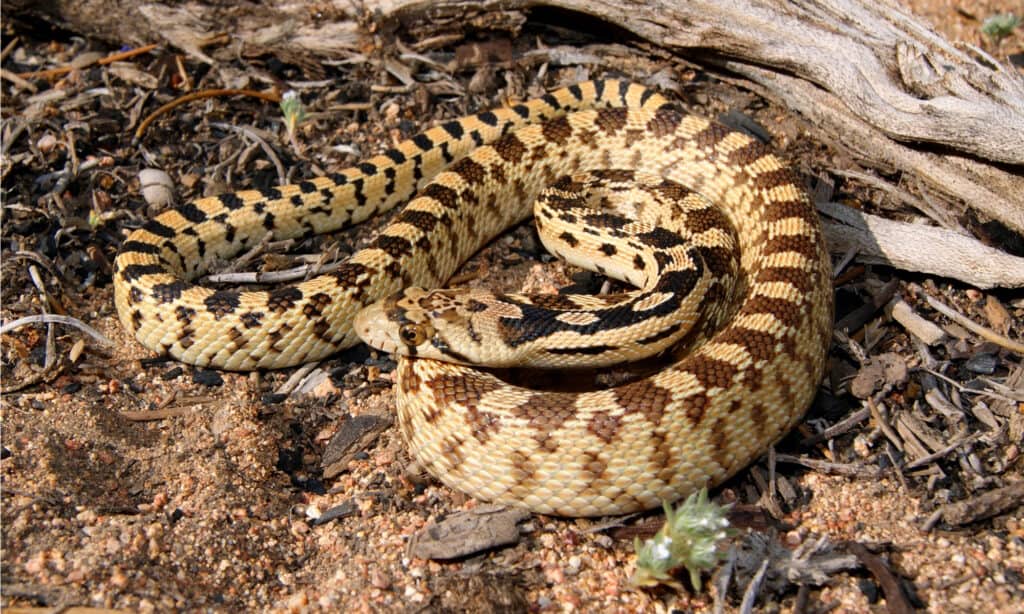
The great basin gopher snake, a subspecies of the gopher snake, lives in southeastern California.
©Matt Jeppson/Shutterstock.com
Another large brown snake in California is the great basin gopher snake, which can reach lengths of up to 54 inches. Great basin gopher snakes are a subspecies of the gopher snake and have yellowish-brown bodies with a series of dark brown to black spots that are connected by narrow lines. They are powerful snakes and prey on a variety of mammals as well as some birds. Great basin gopher snakes are not venomous but when they are threatened they often mimic rattlesnakes by raising their head and flattening their neck while hissing and vibrating their tail. Great basin gopher snakes live in southeastern California in the Mojave desert, grasslands, and forests.
10. Panamint Rattlesnake (Crotalus stephensi)
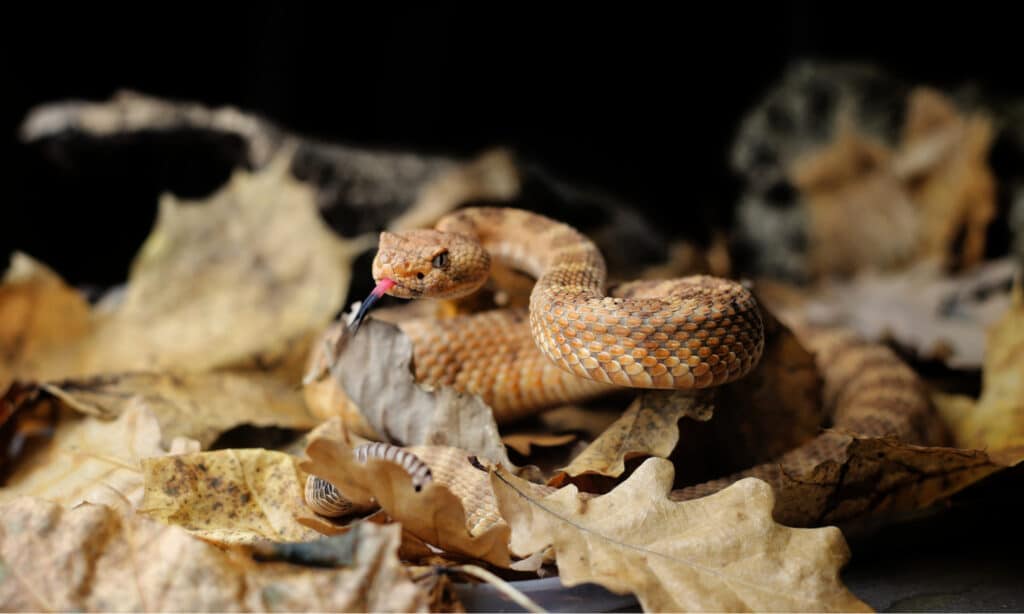
The Panamint rattlesnake preys on small mammals and birds.
©Marina Kehl/Shutterstock.com
Formerly classified as a subspecies of the speckled rattlesnake, the Panamint rattlesnake has now been elevated to species status. Panamint rattlesnakes are 23 to 52 inches long and have heavy bodies but thin necks. They are typically a tan to grey ground color, which is overlaid with a series of brown to reddish-brown crossbands. Quite often, the crossbands become closer together as they near the end of the tail, resulting in one dark band before the rattle. Panamint rattlesnakes occur in the central to the eastern region of the state where they prefer to inhabit rocky hillsides. They are nocturnal snakes and primarily prey on small mammals and birds.
11. Western Black-Headed Snake (Tantilla planiceps)
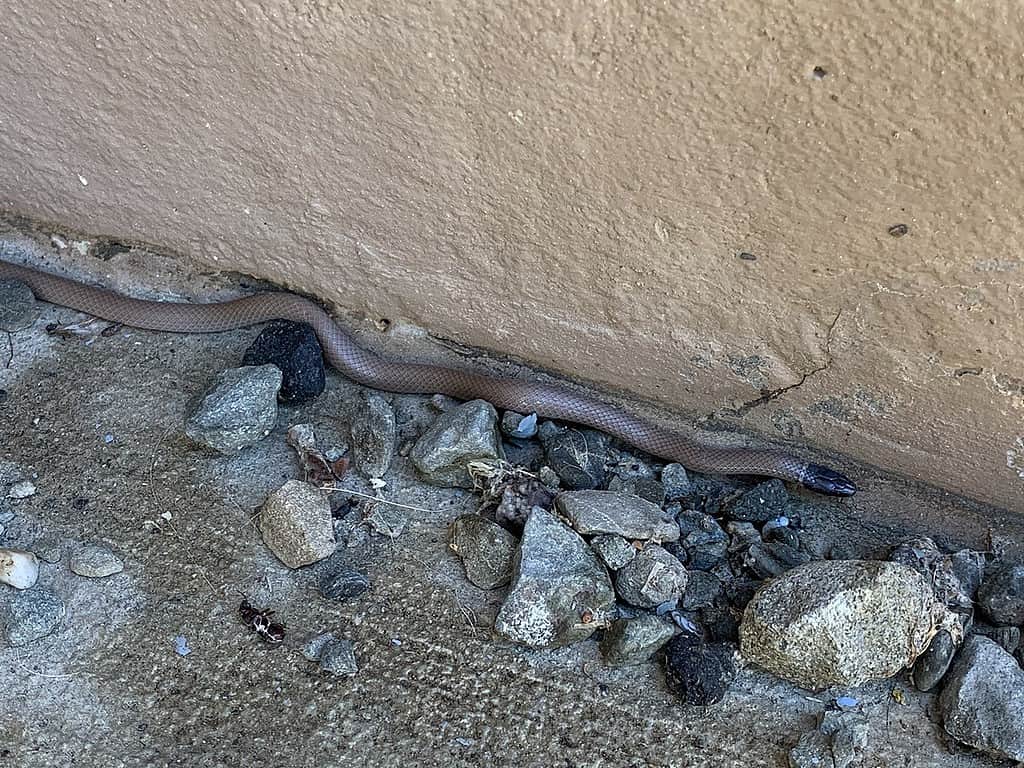
The western black-headed snake’s head is flattened to help them slither into crevices between rocks.
©Miriam Sachs Martin / CC BY 4.0, via Wikimedia Commons – License
The western black-headed snake is a small snake that reaches a maximum of 15 inches long. These snakes have slender bodies with smooth brown scales. They also have a distinctive black head which is flattened to help them slither into crevices between rocks. Western black-headed snakes inhabit deserts, grasslands, woodlands, and chaparral. There are scattered populations across central California, but greater numbers occur along the southern coast. However, these snakes are highly secretive and rarely venture out into the open.
12. Red Diamond Rattlesnake (Crotalus ruber)
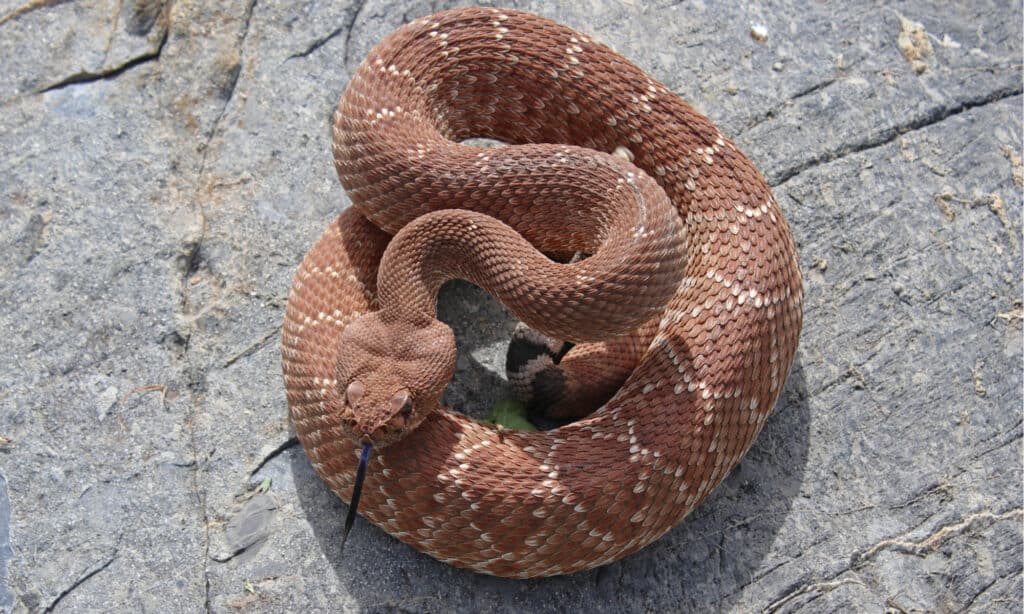
Red diamondback rattlesnakes live in the southwestern region of California.
©Creeping Things/Shutterstock.com
Lastly, we have the red diamond rattlesnake, which lives in the southwestern region of the state in scrubland, coastal chaparral, woodlands, and rocky grasslands. Red diamond rattlesnakes are 30 to 65 inches long and are reddish-tan with diamond-shaped markings. They have fairly mild venom but bites from these snakes can still be deadly without proper treatment and the administration of anti-venom. They prey on a variety of mammals, lizards, and snakes, which they typically hunt during the night.
Summary of 12 Brown Snakes in California (6 Are Venomous)
Here’s a recap of the dozen snakes species with brown colorings found in California we took a look at.
| Number | Snake Species | Scientific Name | Length | Habitat |
|---|---|---|---|---|
| 1 | Baja California Rat Snake | Bogertophis rosaliae | 33 inches to 5 feet | Rocky areas in Baja California |
| 2 | Western Diamondback Rattlesnake | Crotalus atrox | Up to 90 inches | Deserts, including the Mojave and Sonoran deserts |
| 3 | Spotted Leaf-Nosed Snake | Phyllorhynchus decurtatus | 12-20 inches | Colorado, Mojave, and Sonoran deserts |
| 4 | Sidewinder Rattlesnake | Crotalus cerastes | 17-30 inches | Californian deserts |
| 5 | Sharp-Tailed Snake | Contia tenuis | 12-18 inches | Moist woodlands and forests |
| 6 | Northern Pacific Rattlesnake | Crotalus oreganus | 39-64 inches | Grasslands, woodlands, and talus slopes in the north and northwest |
| 7 | Desert Night Snake | Hypsiglena chlorophaea | 12-26 inches | Across southern California in various habitats (e.g. grasslands and deserts) |
| 8 | Mojave Rattlesnake | Crotalus scutulatus | 2-4 feet | Lowlands and deserts in the southeastern region of the state |
| 9 | Great Basin Gopher Snake | Pituophis catenifer deserticola | Up to 54 inches | Southeastern California in the Mojave desert, grasslands, and forests |
| 10 | Panamint Rattlesnake | Crotalus stephensi | 23-52 inches | Rocky hillsides in the central to the eastern region of California |
| 11 | Western Black-Headed Snake | Tantilla planiceps | Up to 15 inches | Deserts, grasslands, woodlands, and chaparral |
| 12 | Red Diamond Rattlesnake | Crotalus ruber | 30-65 inches | Southwestern region of the state in scrubland, coastal chaparral, woodlands, and rocky grasslands |
The photo featured at the top of this post is © Audrey Snider-Bell/Shutterstock.com
Discover the "Monster" Snake 5X Bigger than an Anaconda
Every day A-Z Animals sends out some of the most incredible facts in the world from our free newsletter. Want to discover the 10 most beautiful snakes in the world, a "snake island" where you're never more than 3 feet from danger, or a "monster" snake 5X larger than an anaconda? Then sign up right now and you'll start receiving our daily newsletter absolutely free.
Thank you for reading! Have some feedback for us? Contact the AZ Animals editorial team.






